Podcast: Play in new window | Download
Subscribe: Apple Podcasts | RSS
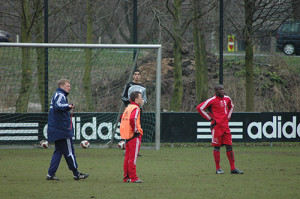 Last week reviewed the possible formations for teams playing 7 v 7. My focus was on U9 and U10 teams but I received an email from Bryan, a coach in Maryland, who coaches a U15 girls team. He found the episode useful for his team even though they play 11 v 11 but they usually play 7 v 7 or 8 v 8 at the end of training sessions so he will use the different formations I described to focus on various aspect of the game that he wants to highlight. So even if you’re team doesn’t play their games small-sided the formations included in this episode and the last one can still be useful.
Last week reviewed the possible formations for teams playing 7 v 7. My focus was on U9 and U10 teams but I received an email from Bryan, a coach in Maryland, who coaches a U15 girls team. He found the episode useful for his team even though they play 11 v 11 but they usually play 7 v 7 or 8 v 8 at the end of training sessions so he will use the different formations I described to focus on various aspect of the game that he wants to highlight. So even if you’re team doesn’t play their games small-sided the formations included in this episode and the last one can still be useful.
This week I describe the formations you should consider when playing 9 v 9. This is an important transitional period since it’s the final stage before the players move to the full sided game. So not only should you consider the developmental benefits of each system but also how they might help your players gain a better understanding of what they’ll do in the full sided game in a couple of years.
This includes seven different formations that I think could be used for 9-a-side soccer along with the advantages and disadvantages of each one. I also describe how using each one can teach your players something different about the game as well as which 11 v 11 systems they can be transformed into. At the end I’ll tell you which two systems I prefer and give you some activities to train the key concepts that I think are important for your players to understand to play within the formations most effectively.
As part of the upcoming changes to the format of small-sided games in the US our U11 and U12 teams will now be playing 9 v 9 rather than 8 v 8. I’m pleased that US Soccer recommended this change because I think having nine players on the field allows for more flexible formations to be used in order to teach different aspect of the game.
As I said in last week’s episode on the new 7 v 7 format, our primary motivation at these young ages should be on the technical and tactical development of our players rather than results. It’s with this in mind that I’ll discuss the various formations that you can use in order to select the one or two that will work best for your team.
There may be others that I haven’t considered. If there’s one that you’ve had success with please tell us about it in the comments section of this episode on CoachingSoccerWeekly.com.
2-4-2
- Advantages
- Two Forwards
- Great midfield presence
- Excellent width
- Disadvantage
- Two in the back
- Ok if other team is playing one forward
- Two in the back
- Transfer
- 4-4-2
- What does it teach?
- Pressure and cover in defense
- Wingers staying wide
- Working up and down the wings
- Relationship of Forwards
2-1-3-2
- Advantages
- It might not seem much different than 2-4-2
- The key is the holding CM
- Holding CM to screen for two defenders
- Still have good width
- Two Forwards
- It might not seem much different than 2-4-2
- Disadvantages
- Two in the back
- Transfer
- 3-5-2
- What does it teach?
- Holding Mid
- Attacking Center Mid
- Relationship between Center Mids
- Pressure and cover in defense
2-3-3
- Advantages
- Width in midfield and attack
- Can play three Mids in the center
- Great attacking shape
- Disadvantages
- Still only two in the back
- Committing a lot of players to forward positions
- Isolated CM
- Transfer
- 4-3-3
- What does it teach
- Wingers playing a position and a half
- Triangle in midfield
3-4-1
- Advantages
- Good cover in the back
- Great width in midfield
- Numbers in the center of midfield
- Diamonds of support
- Disadvantages
- Only one forward
- But attacking CM is able to join the attack with cover from the HCM
- Only one forward
- Transfer
- 4-4-2
- What does it teach?
- Wingers
- Outside backs
- Lone striker
- CM relationship
- Different ways to play them
3-1-3-1
- Advantages
- Very balanced
- Very fluid
- Outside backs can push up
- WM can go up or back
- Cover in the back
- HM
- Attacking Mids to support the Forward
- Disadvantages
- Lone Forward
- Transfer
- 4-2-3-1
- What does it teach?
- Transition up and back
- Easy to create angles of support
4-3-1
- Advantages
- Four in the back
- Play three CM centrally
- Disadvantages
- Lone Forward
- Width only in the back
- Very defensive
- Transfer
- 4-3-3
- What does it teach?
- Outside Back pushing up
- Midfield three
My preference is to start with a 3-3-2 because it’s such an easy transition from the 3-3-1 formation that we have been playing in the 8 v 8 format. As the players become comfortable with this formation I will also introduce the 3-1-3-1 because of it’s flexibility and how easy it is for players in all positions to transition back and forth between attacking to defending phases.
Training Exercises
3 v 3 Exercise and Small-Sided Game
This begins as an exercise for the defenders to work on pressuring and covering with the ball in different positions on the field. Once they are comfortable with the concepts then you can make it a game where the attacking team attempts to get the ball across the endline and the defending team works to pressure and cover effectively to prevent this.
Triangle Passing
There are many triangle and diamonds created by both of these systems so working on the passing patterns that were described in Episode 8 – The Triangle Training Method. Will help create patterns that are useful for possessing the ball in these formations.
Dutch Wine Glass
This is a great pattern for working on playing up, back and through. The exercise can also be transformed into a shooting environment as described in Episode 34 – Getting More Out of Your Finishing Exercises.
You can use any number of these formations to give your players an introduction to different ways to play or you can settle on one that will give you the easiest transition to the 11v11 game. I like to use two different setups so that they can see the strengths and weaknesses of each one without constantly changing so that the players are not overwhelmed.
Whichever way you decide to go, make sure that stay focused on preparing your players technically and tactically so that they’ll be ready for the next step when the time comes.
Printable Show Notes
The show notes for each episode are accessed through the WCC Training Center.
They are FREE but you will need at least a Free Membership to the Training Center in order to view and print them.
Click on the image of the notes and if you’re already logged in to the Training Center you’ll be taken to the Podcast page. If you’re not logged in your be taken to a login page where you’ll also be able to login or register if you are not already a Member.
Remember!
Make sure you subscribe to Coaching Soccer Weekly through iTunes, or your podcast provider of choice, to be sure you never miss an episode.
I would appreciate it if you would leave a 5 star rating and a written review on iTunes to help spread the word about the show and the information that we are sharing here.
You can now subscribe through Google Play Music to listen to the podcast on your Android device.
In the Next Episode
Next week I’ll look at another important challenge that players are faced with each year but it’s even more magnified with the age group changes occurring next year. How do you best prepare your players for the transition to 11 v 11 soccer?


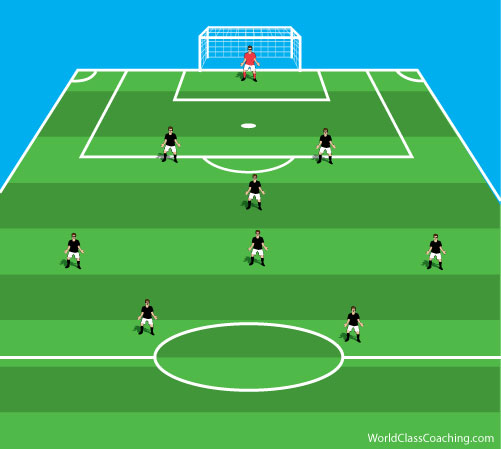
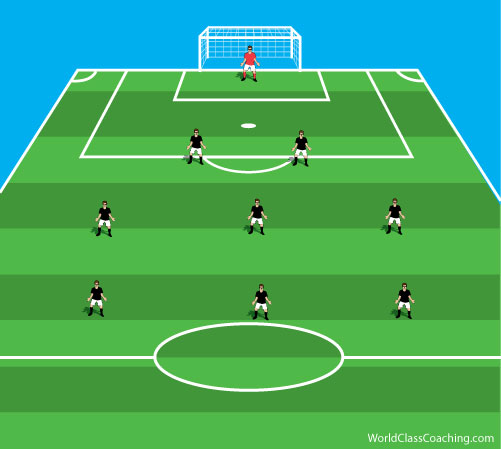


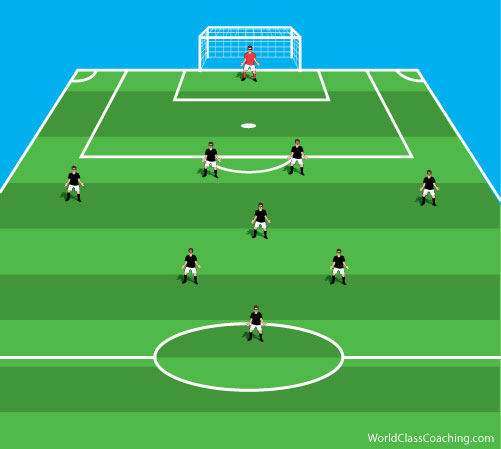
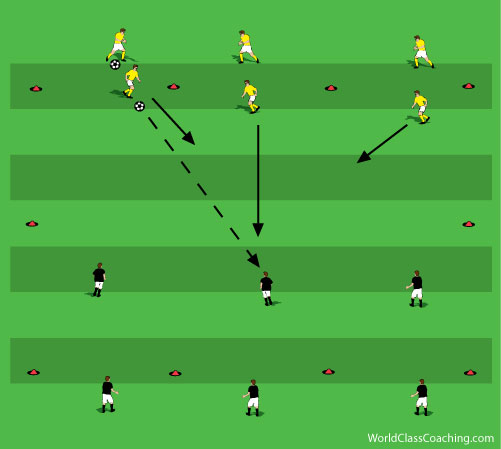
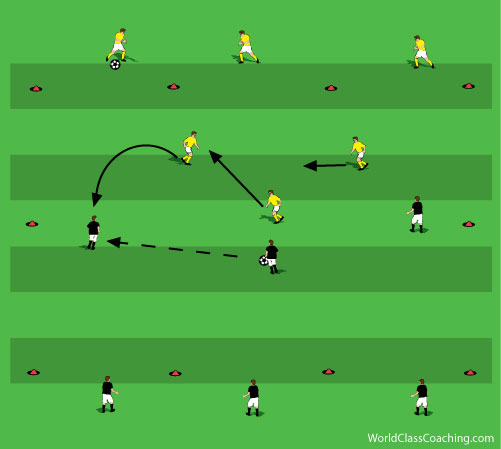
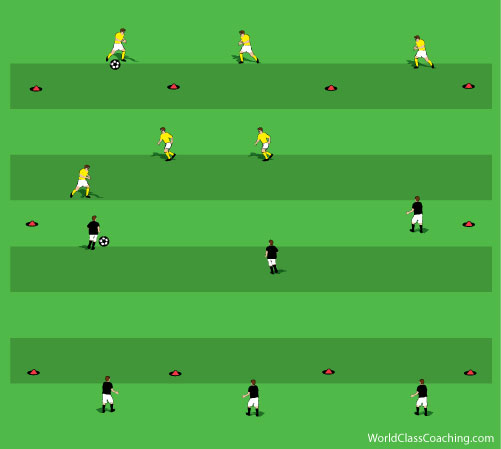
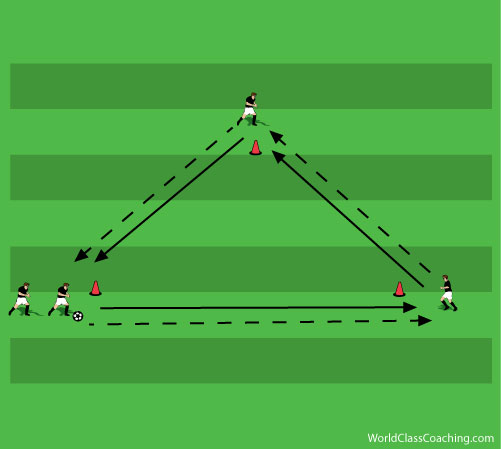
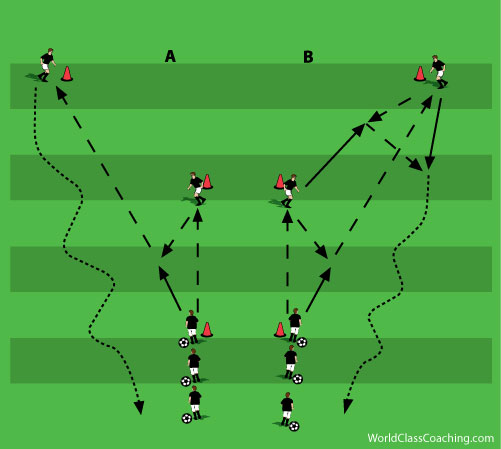

We are just about to move up from 7-a-side to 9-a-side next season and in our preparatory friendly games so far we have gone with a 3-3-1-1 formation and it seems to work.
We go three at the back, three midfielders and one player in what we refer to as the ‘number 10’ position*, plus one striker.
(*THE NUMBER 10 ROLE:- 10 in squad number terms, is the number given to the player who embodies creativity, flamboyance, imagination and inspiration through their play.
The number has become synonymous with the position between midfield and attack, whether it be as a forward dropping deep, or a midfielder pushing on.
The number has been worn by great players in the past such as Maradona, Pele, Zico, Platini and Baggio. Lionel Messi at Barcelona is a current example of a team that play with a ‘number 10’ and equally as important is Wayne Rooney who contributes a great number of goals as well as assists in his Manchester United side.)
That’s a great variation of the 3-3-2 that would help train the #10.